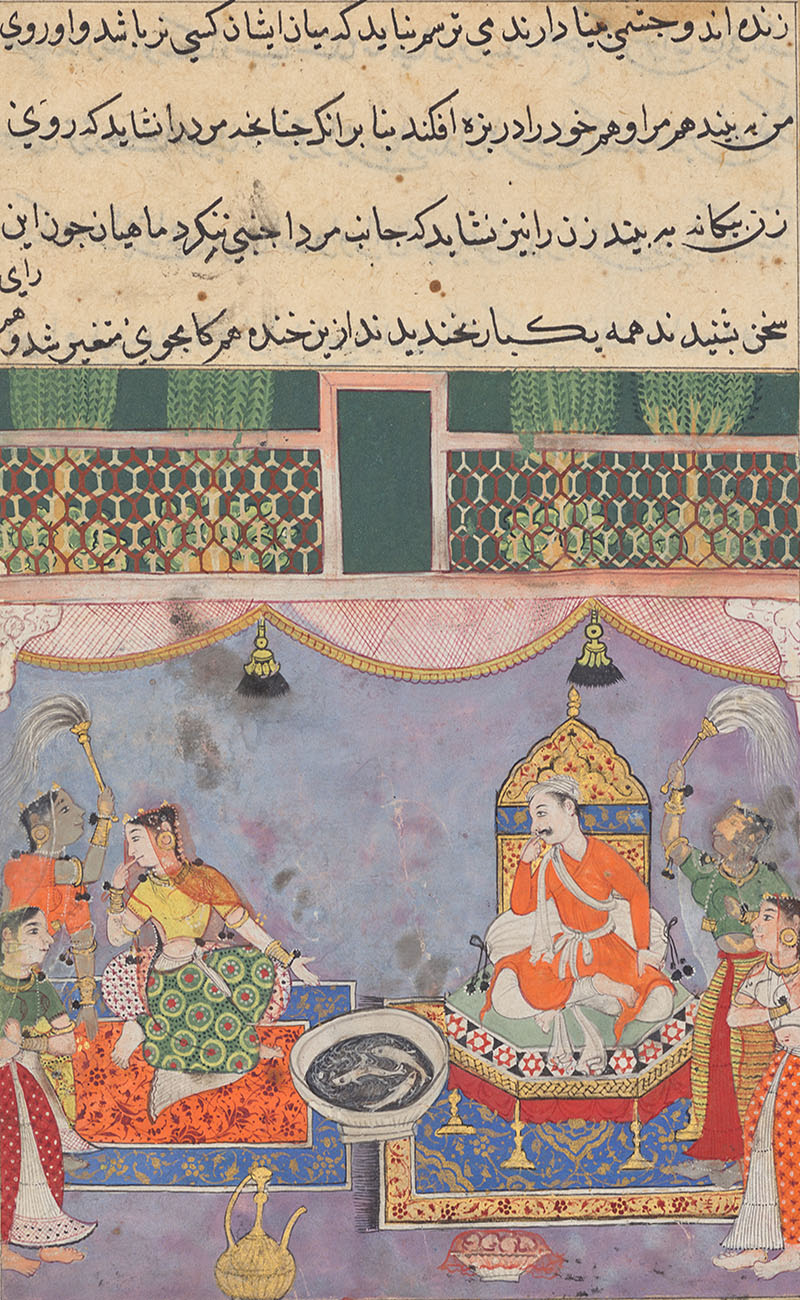A fourteenth-century literary work, the Tutinama, literally meaning “Tales of a Parrot,” is a series of fifty-two stories by the Sufi author Ziya al-Din Nakhshabi. The stories are told over the course of fifty-two nights by the pet parrot of a man named Maymun to Maymun’s wife Khujasta, in order to keep her distracted with the stories and prevent her from leaving to meet her lover.
The best-known version of the story remains a lavishly illustrated sixteenth-century manuscript made under Emperor Akbar’s patronage and most likely overseen by Mir Sayyid Ali and Abd al-Samad. Currently housed at the Cleveland Museum of Art, it was seen as one of the earliest examples of Mughal miniature painting, commissioned at a time when the style was still taking shape. The manuscript does not possess the consistency characteristic of an established style, and later scholarship discovered that nearly two-thirds of the illustrations had been painted over incomplete images made in a style similar to the Delhi Sultanate era Chandayana, suggesting that several artists who worked on the manuscripts may already have been trained in older manuscript painting traditions. The strategic way in which the earlier version was painted over, mainly in the facial gestures and costumes that later became characteristic of the Mughal style, indicates that what scholars had at first taken to be a nearly finished transitory style is in reality a set of retouched illustrations.
The distinct colour scheme of the Tutinama illustrations has backgrounds rendered in deep solid red, canary yellow or pink and the lighter tone of the (coarse) ultramarine, which was markedly different from the Hamzanama paintings that came after. The detailed images are accompanied by text written in the nastaliq script. Painted on thin, light paper, the pages in the manuscript were bound and margined again, most likely during the nineteenth century, before it became part of the collection.
There were two versions of the manuscript created during Akbar’s reign — in the 1560s and the 1580s. The version at the Cleveland Museum originally consisted of 341 folios, of which thirteen are either missing or in other collections. Most of the second copy of Akbar’s Tutinama, made in the early 1580s, is housed in the Chester Beatty Library, Dublin.






![The façade of the Maneckji Seth Agiary, a Zoroastrian fire temple, is a standout example of the popularity of the Persian Revival Style in Western India in the 19th and 20th centuries. This style was often seen in the architectural patronage of the Parsis, who emerged as one of the most influential mercantile communities of British India. Popular motifs of this style, like the mythical lamasus (winged bulls with human heads) and the faravahar (a winged guardian spirit in Zoroastrianism), drew on the historical art and architecture of the Achaemenid and Sasanian empires from sites like Persepolis, Bisotun, Taq-e Bostan, Naqsh-e Rostam and Naqsh-e Rajab in Persia.
The Parsi community’s adoption of this style occurred largely due to their networks of global commerce and politics, allowing them to access and translate research of ancient Persia into visible symbols that underlined their association with antiquity, imperial power, and art.
نمای آتشکدهی زرتشتی مانِکجی سِت نمونهی بارزی از رواج سبک «احیای [معماری] ایرانی» در غرب هند طی سدههای نوزدهم و بیستم است. این سبک غالباً در بناهایی دیده میشد که پارسیان، از بانفوذترین جوامع بازرگان در هند بریتانیا، بانیشان بودند. نقشمایههای محبوب این سبک، مانند گاو بالدار اساطیری (لاماسو) و فَروَهَر (روح بالدار نگهبان در دین زرتشت)، برگرفته از هنر و معماری شاهنشاهی هخامنشی و ساسانی، در جاهایی چون تخت جمشید و بیستون و طاق بستان و نقش رستم و نقش رجب، بود.
اقتباس جامعهی پارسیان از این سبک بسیار مرهون روابط گستردهی تجاری و سیاسی آنها بود که دسترس به پژوهشها دربارهی ایران باستان و برگردانیدن آنها به نمادهای بصری را ممکن میکرد و بر پیوند پارسیان با دوران باستان و قدرت شاهنشاهی و هنر تأکید میکرد.](https://mapacademy.io/wp-content/plugins/instagram-feed/img/placeholder.png)
